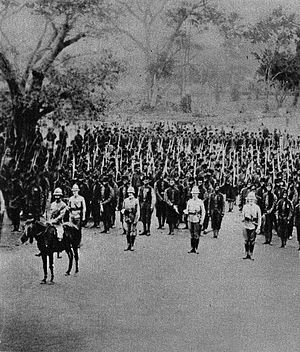Togoland campaign
| Togoland Campaign | |||||||||
|---|---|---|---|---|---|---|---|---|---|
| Part of the African theatre of World War I | |||||||||
 British troops in Togoland in 1914 |
|||||||||
|
|||||||||
| Belligerents | |||||||||
| Commanders and leaders | |||||||||
|
Charles M. Dobell Frederick Carkeet Bryant |
Hans-Georg von Döring (POW) Georg Pfähler † |
||||||||
| Units involved | |||||||||
|
West African Frontier Force Tirailleurs Senegalais |
Paramilitary and police forces | ||||||||
| Strength | |||||||||
| British: 600 France: 500 |
693–1,500 (including reservists) | ||||||||
| Casualties and losses | |||||||||
| British: 83 French: ~54 |
41 | ||||||||
|
|
|||||||||
The Togoland Campaign (9–26 August 1914) was a French and British invasion of the German colony of Togoland in west Africa, during the West African Campaign of the First World War. German colonial forces withdrew from the capital Lomé and the coastal province and then fought delaying actions on the route north to Kamina, where a new wireless station linked Berlin to Togoland, the Atlantic and South America. The main British and French force from the neighbouring colonies of Gold Coast and Dahomey, advanced from the coast up the road and railway, as smaller forces converged on Kamina from the north. The German defenders were able to delay the invaders for several days at the battles of Agbeluvhoe and Chra but surrendered the colony on 26 August 1914. In 1916, Togoland was partitioned by the victors and in July 1922, British Togoland and French Togoland were established as League of Nations mandates.
...
Wikipedia

